
All Solutions
Page 120: Lesson Check
#### Known
A scalar is fully described with a number.
A vector is fully described with a number (its length) and a direction.
Therefore:
The difference is that vectors have direction.
Note that units of measurement are not essential to define a scalar or a vector.
—
#### Conclusion
The difference is that vectors have direction.
#### Known
The magnitude of a vector refers to its length, while the direction refers to its orientation.
—
#### Conclusion
The magnitude of a vector refers to its length.
#### Known
Defining the magnitude of a vector $vec{r}$ as $r$, we have:
$$
begin{align*}
r=sqrt{r^2_x+r^2_y} (tx{Pythagorean theorem.})
end{align*}
$$
Where $r_x$ is the $x$ component and $r_y$ is the $y$ component of the vector.
—
#### Conclusion
$$
begin{align*}
boxed{r=sqrt{r^2_x+r^2_y}}
end{align*}
$$
Graphically:
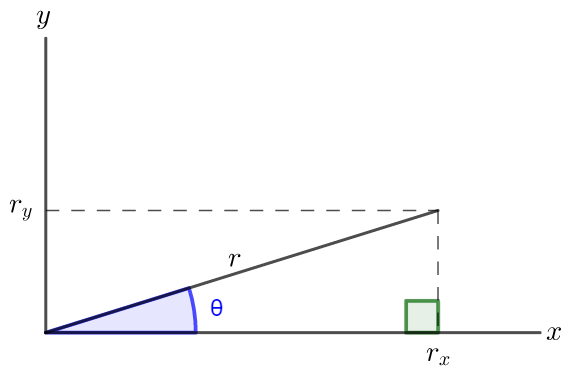
begin{align*}
boxed{r=sqrt{r^2_x+r^2_y}}
end{align*}
$$
#### Known
A vector is defined by its length and direction.
Therefore:
When we solve a vector, it is because we know its length (magnitude) and direction.
—
#### Conclusion
To know its length and direction.
#### Known
For a vector $vec{r}$ with $r_x$ and $r_y$ components we have:
$$
begin{align*}
&r=sqrt{r^2_x+r^2_y} (tx{magnitude}) tx{and}\
&theta=tx{tan}^{-1}left(frac{r_y}{r_x}right) (tx{direction})
end{align*}
$$
#### Calculation
a) Therefore if the components are duplicated, the magnitude increases, this is:
$$
begin{align*}
r’=sqrt{(2 r_x)^2+(2 r_y)^2}=2 sqrt{r^2_x+r^2_y}=2 r
end{align*}
$$
$$
begin{align*}
boxed{r’=2 r}
end{align*}
$$
b) The direction angle is the same:
$$
begin{align*}
theta’=tx{tan}^{-1}left(frac{2 r_y}{2 r_x}right)=tx{tan}^{-1}left(frac{r_y}{r_x}right)=theta
end{align*}
$$
$$
begin{align*}
boxed{theta’=theta}
end{align*}
$$
#### Conclusion
a) The magnitude increases.
b) The direction angle is the same.
b) The direction angle is the same.
#### Known
The Pythagorean theorem:
$$
begin{align}
d=sqrt{x^2+h^2}
end{align}
$$
#### Calculation
Givens: $h=24 tx{m}$, $x=320 tx{m}$
From (1):
$$
begin{align*}
d=sqrt{(320 tx{m})^2+(24 tx{m})^2}=321 tx{m}
end{align*}
$$
—
#### Conclusion
During the descent the plane covers a distance of $321 tx{m}$ meters.
Graphically:
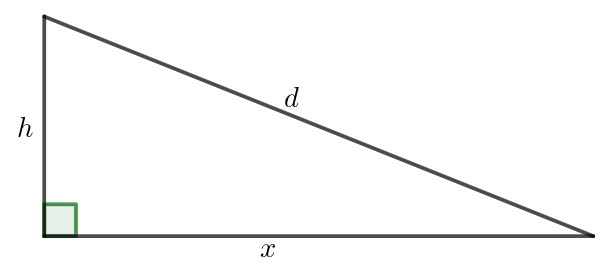
#### Known
For the components of a vector, $r_x$ and $r_y$ and its magnitude r, the following relationships hold:
$$
begin{align*}
theta=tx{tan}^{-1}left(frac{r_y}{r_x}right) tx{or} theta=tx{sin}^{-1}left(frac{r_y}{r}right) tx{or} theta=tx{cos}^{-1}left(frac{r_x}{r}right)
end{align*}
$$
#### Calculation
Givens: $r=2.4 tx{km}=2.4times10^3 tx{m}$, $r_y=160 tx{m}$
Using:
$$
begin{align*}
theta=tx{sin}^{-1}left(frac{r_y}{r}right)=tx{sin}^{-1}left(frac{160 tx{m}}{2.4times10^3 tx{m}}right)=3.8^circ
end{align*}
$$
—
#### Conclusion
The angle of the road above the horizontal is $3.8^circ$.
Graphically:
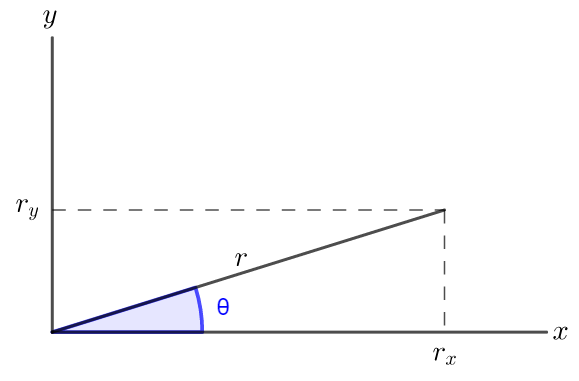
#### Known
For a vector $vec{r}$, the components are given by:
$$
begin{align}
r_x=r tx{cos}(theta)hspace{0.5cm} tx{and}hspace{0.5cm} r_y=r tx{sin}(theta)
end{align}
$$
Where $theta$ is the angle that the vector makes with the positive x-axis.
#### Calculation
Givens: $r=760 tx{m}$, $theta=35^circ$ (north of east)
From (1):
$$
begin{align*}
&r_x=(760 tx{m}) tx{cos}(35^circ)=623 tx{m}\
&r_y=(760 tx{m}) tx{sin}(35^circ)=436 tx{m}
end{align*}
$$
—
#### Conclusion
$$
begin{align*}
boxed{r_x=623 tx{m}hspace{0.5cm} tx{and} hspace{0.5cm} r_y=436 tx{m}}
end{align*}
$$
.
Graphically:
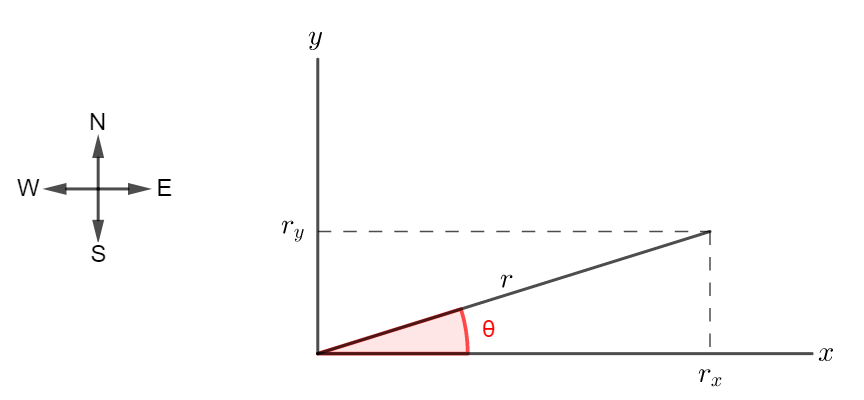
r_x=623 text{m}hspace{0.5cm} text{and} hspace{0.5cm} r_y=436 text{m}
$$
#### Known
The direction angle of a vector $vec{r}$ with components $r_x$ and $r_y$, is given by:
$$
begin{align}
theta=tx{tan}^{-1}left(frac{r_y}{r_x}right)
end{align}
$$
#### Calculation
Givens: $r_x=22 tx{m}$, $r_y=4.8 tx{m}$
From (1):
$$
begin{align*}
theta=tx{tan}^{-1}left(frac{4.8 tx{m}}{22 tx{m}}right)=12.3^circ
end{align*}
$$
—
#### Conclusion
$$
begin{align*}
boxed{theta=12.3^circ}
end{align*}
$$
Graphically:
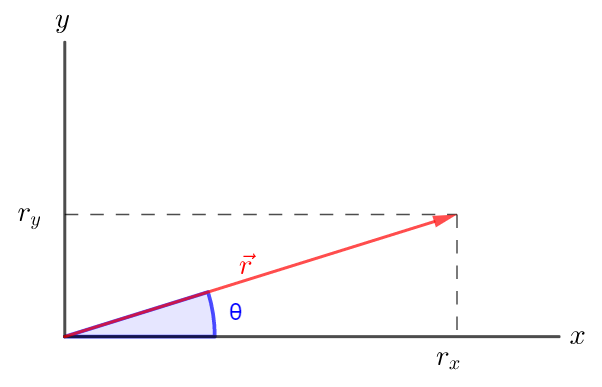
Haven't found what you were looking for?
Search for samples, answers to your questions and flashcards

